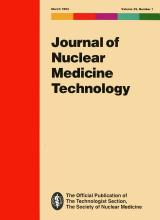Abstract
Objective: The standard 30-mCi technetium-99m (99mTc) equilibrium radionuclide angiogram (RNA) dose for evaluating cardiac function has long been a problem in two respects: (1) unnecessarily high doses in smaller patients and (2) poor count statistics in larger patients. To rectify these problems, a dose chart was created based on height, weight, and gender to assist in the dispensing of an appropriate RNA dose.
Methods: The chart created is based on the 1983 Metropolitan Weight & Height Tables, which state the normal ranges of weight for men and women according to their respective heights. The 30-mCi dose was used for this normal range, and 1 mCi was added or subtracted for every 10-pound deviation from this range. We prospectively applied our chart to 91 patients and calculated the counts/pixel within the left ventricular region. The study group was divided into three groups: (Group A) patients who received 30 mCi (52 ± 11 counts/pixel, n = 32), (Group B) patients who received less than 30 mCi (56 ± 8 counts/pixel, n = 28), and (Group C) patients who received greater than 30 mCi (54 ± 12 counts/pixel, n = 31). We retrospectively identified 12 patients (Group D) who received the standard 30-mCi dose, but would have received a reduced dose if our chart had been used.
Results: There was no significant difference (p = 0.22) in counts/pixel among these three groups despite a very significant difference (p = 0.001) in weight. Image quality remained consistently good throughout the study. In contrast, Group D had significantly higher counts per pixel (78 ± 17 counts/pixel, p = 0.001) when compared to the other groups, indicating a need for dose reduction.
Conclusions: These data clearly demonstrate that dosage adjustment by our chart avoided excess radiation in thin patients and ensured adequate counting statistics in heavy patients.







